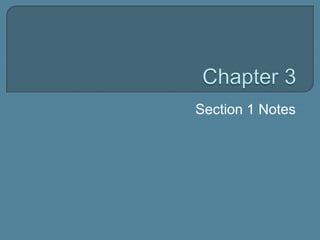
WH Chapter 3 Section 1 Notes
- 2. In 1922, archaeologists in northwestern India made a huge discovery Digging in the Indus River valley they discovered evidence of a lost civilization believed to be 3500 years old The Indus River valley is located on the Indian subcontinent Subcontinent---large landmass that juts out from a continent
- 5. The Indian subcontinent is a huge, wedge- shaped peninsula extending into the Indian Ocean Today, it includes 3 of the world’s 10 most populous countries---India, Pakistan, and Bangladesh The northern border of the subcontinent is framed by the towering, snow-covered Hindu Kush and Himalaya mountain ranges
- 10. The Indian subcontinent is divided into three major zones: the well-watered northern plain, the dry triangular Deccan, and the coastal plains on either side of the Deccan
- 11. The northern plain lies just south of the mountains This fertile region is water by mighty rivers: the Indus (which gives India its name), the Ganges*, and the Brahmaputra These rivers and their tributaries carry melting snow from the mountains to the plains, making agriculture possible
- 13. The most recognizable feature on any map of India is the Deccan This triangular plateau juts into the Indian Ocean The Deccan lacks melting snows that feed the rivers of the north and provide water and irrigation As a result, much of the Deccan is arid, unproductive, and sparsely populated
- 14. The coastal plains are separated from the Deccan by low-lying mountain ranges, the Eastern and Western Ghats Rivers and heavy seasonal rains provide water for farmers People use the seas for fishing and as highways for trade
- 15. Today, as in the past, a defining feature of Indian life is the monsoon, a seasonal wind In October, the winter monsoons blow from the northeast and bring a flow of hot, dry air that withers crops In late May or early June, the wet summer monsoons blow from the southwest and drench the land with daily downpours
- 16. The monsoon has shaped Indian life Each year, people welcome the rains that are desperately needed to water the crops If the rains are late, famine and starvation may occur If the rains are too heavy, rushing rivers unleash deadly flooding
- 17. The earliest Indian civilization emerged in the Indus River valley in present-day Pakistan about 2500BC This civilization flourished for 1000 years then vanished without a trace Archaeologists have not fully uncovered many Indus Valley sites
- 18. The two main cities, Harappa and Mohenjo-Daro may have been twin capitals Both were large and were about three miles in circumference Each was dominated by a massive hilltop structure, probably a fortress or temple Both cities had huge warehouses to store grain brought in from outlying villages
- 19. The most striking feature of Harappa and Mohenjo-Daro is that they were so carefully planned Each city was laid out in a grid pattern All houses were built of uniform oven-fired clay bricks Houses had surprisingly modern plumbing systems, with baths, drains, and water chutes that led into sewers beneath the streets
- 23. Archaeologists have concluded that the Indus Valley cities had a well-organized government Powerful leaders made sure the people had a steady supply of grain The rigid pattern of building and the uniform brick sizes suggest government planners
- 24. Most Indus Valley people were farmers They great a wide variety of crops that included wheat, barley, melons, and dates They were the first people to cultivate cotton and weave its fibers into cloth
- 25. Some people were merchants and traders Their ships carried cargoes of cotton cloth, grain, copper, pearls, and ivory combs By hugging the Arabian Sea coast and sailing up the Persian Gulf, Indian vessels reached the cities of Sumer Contact with Sumer may have stimulated Indus Valley people to develop their own system of writing
- 26. The peoples of the Indus Valley civilizations were polytheistic A mother goddess, the source of creation, seems to have been widely honored Indus people also worshipped sacred animals, including the bull Some scholars think these early practices influenced later Indian beliefs, especially veneration for cattle
- 27. Began the excavation of Harappa and Mohenjo-Daro in the 1940s Wheeler was a noted scientist but also had a reputation as a scoundrel His scandals, self-promotion, and success--- combined with his manipulation of the press-- -drew thousands of visitors to his sites Possibly more than any other person, Wheeler is responsible for the public’s fascination with the work of archaeologists